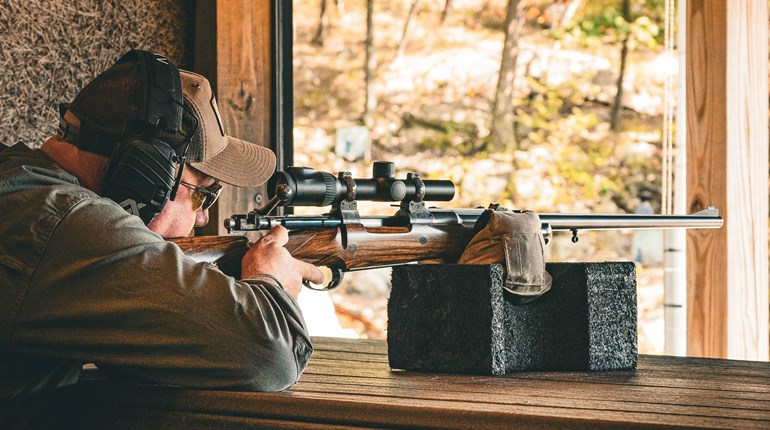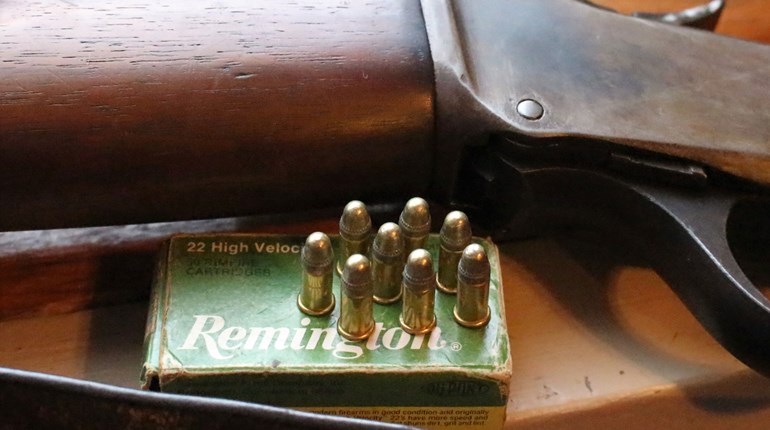
During the late 19th century and into the early 20th century, when the boundaries of cartridge capabilities were being simultaneously defined and broken, certain cartridges rose to the top. With the colonization of East Africa and India, British hunters were regularly pursuing the most dangerous game on the planet, including the elephant, Cape buffalo, rhinoceros, gaur, tiger, lion, leopard and hippopotamus. The transition from blackpowder to smokeless, and from pure lead projectiles to what we now know as the jacketed softpoint, and onto the non-expanding ‘solid’ bullets certainly changed the capabilities of the known cartridges.

Among the dangerous game cartridges which successfully made the transition to earn its place as the industry standard is the .450 3¼-inch Nitro Express. The .450 Black Powder Express certainly paved the way, but John Rigby & Company released the smokeless version in 1898, a rimmed affair driving a 480-grain bullet of .458-inch diameter to a muzzle velocity of 2150 fps via a charge of 70 grains of Cordite, the long, thin spaghetti-like propellant of the era. The case is straight-walled and gently tapering, measuring 3¼ inches, and was designed for the single-shot and double rifles so popular in that era.
The .450’s formula would go on to define what we now consider to be the proper specs for a stopping rifle cartridge, as it develops just under 5,000 ft.-lbs. and has a recoil level manageable by most hunters. The projectiles—while of cup-and-core construction—have a sectional density (SD) value of 0.327, and will give the necessary penetration for thick skinned animals; our premium bullets only make this vintage cartridge even better. The uprisings in India and Sudan led to a 1907 British ban on all .45-caliber ammunition in its colonies and territories—predominately to keep the .577/450 Martini-Henry ammo and any similar components out of the hands of the insurgents—and many different alternatives to the .450 NE formula were introduced, not the least popular of which is the .470 NE. The fact that the .450 was imitated in so many different ways, and I’ll point to the .500/465 NE, .475 NE, .475 No. 2 Jefferies and .476 NE, is a testament to the effectiveness of the cartridge.

During the post-WWII era, when both travel and safari hunting began to gain a head of steam once again, Britain’s premier ammunition manufacturer—Kynoch—began to slowly but assuredly fade away, and the ammunition for the so many of the classic British rifles simply dried up. Winchester saw the void, and immediately set out to fill it with an affordable and available cartridge with their name on it. Their solution? The .458 Winchester Magnum, which was designed to replicate the ballistics of, wait for it, the .450 Nitro Express. The .458 Win. Mag. originally used a 510-grain bullet at an advertised muzzle velocity of 2150 fps, though it didn’t make it to that benchmark for a number of years. Based on a shortened .375 H&H belted case, the .458 Winchester will give .450 NE ballistics in a repeating rifle, and remains a popular choice in Africa among Professional Hunters and visiting sportsmen alike.
The .450 NE was the chosen cartridge of Capt. C.H. Stigand and the Hon. Denys Finch Hatton (of Out of Africa fame) and while it is available in a good number of vintage double rifles and single shots, there are modern rifles available for the classic cartridge. Heym’s excellent model 89B double rifle is available in .450 NE and the highly popular Ruger No. 1 single shot rifle was also available so chambered, in their Tropical line.

Hornady has played a big role in keeping the older safari cartridges alive, and the .450 3¼-inch Nitro Express is no exception. They offer their duo of 480-grain DGX Bonded softpoint and DGS full metal jacket solid, at a muzzle velocity of 2150 fps—this is the velocity at which so many of the vintage double rifles were regulated—so should you find a rifle which tickles your fancy, there is at least one good source of American ammunition.
For those who handload, components for the .450 NE are readily available. The myriad of .458-inch diameter bullets made for the .458 Winchester Magnum, .458 Lott, .450 Rigby, .45-70 Government and will all work in the .450 NE, though be aware that if you own a double rifle, it will more than likely require the 480-grain bullets for which it was regulated. Hornady makes component cases as well as resizing dies.

It seems a bit of a shame that the .450 NE has become such a limited product, as it truly is a great design. But it is clearly evident that the .470 NE won the popularity contest, even in my gun safe. Even John Rigby & Co. adopted Joseph Lang’s .470 after the 1907 ammo ban, and I feel that when Federal reintroduced .470 NE ammunition in 1989, that may have been the death knell for the .450, though it hangs on by a thread. For the hunter, the field performance of the two cartridges is so close it is negligible. The .470 has a bit more frontal diameter, the .450 has a better SD; and the 20-grain difference in weight shouldn’t make a difference at all. However, the wider availability of the .470 ammunition has given those rifles a greater resale value.
We all owe the .450 3¼-inch Nitro Express a debt of gratitude, even if for the fact that it established a ballistic formula upon which so many dangerous game hunters rely. Among the professional hunters I’ve shared a camp with, only one has readily used a .450 NE, but in spite of the rarity, it remains a reliable cartridge for nearly any hunting situation involving dangerous game at close quarters.
Looking for previous installments of our "Behind the Bullet" series? We've got you covered.
• .17 Hornet
• 7mm STW
• 6.8 Western
• .375 Ruger
• .223 Remington
• 6.5x55 Swedish
• .416 Remington Magnum
• .300 Winchester Short Magnum
• 28 Nosler
• 6.5 PRC
• .22 WMR
• .458 Winchester Magnum
• .22 Hornet
• .280 Ackley Improved
• .240 Weatherby Magnum
• .458 Lott
• .264 Winchester Magnum
• .348 Winchester
• .33 Nosler
• .260 Remington
• .30-30 Winchester
• .416 Rigby
• .358 Norma Magnum
• .22 LR
• 7mm-08 Remington
• 8mm Remington Magnum
• .338 Federal
• .224 Valkyrie
• .338-06 A-Square
• 9.3x62mm Mauser
• .257 Weatherby Magnum
• .45-70 Government
• .300 H&H Magnum
• .25-06 Remington
• .30-06 Springfield
• 6.5 Creedmoor
• .300 Remington Ultra Magnum
• 7mm Remington Magnum
• .470 Nitro Express
• .280 Remington
• .300 Winchester Magnum
• .270 Winchester
• .222 Remington
• .45 ACP
• .404 Jeffery
• .44 Remington Magnum
• .41 Remington Magnum
• .243 Winchester
• .338 Winchester Magnum
• .357 S&W Magnum
• 6.5-284 Norma
• 8x57 Mauser
• .38 Smith & Wesson Special
• 7x57mm Mauser
• 9mm Luger
• .35 Whelen
• .454 Casull
• .375 H&H Magnum
• .45 Colt
• .22-250 Remington
• 10mm Auto
• .308 Winchester



































